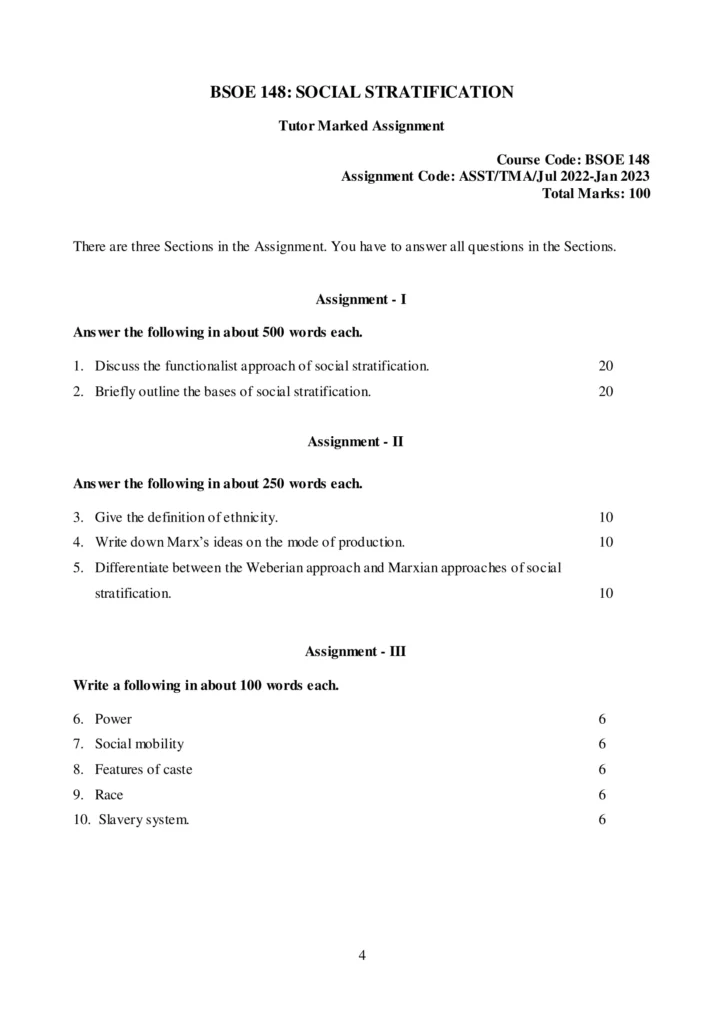Contents
- 1 Assignment – I
- 2 Answer the following in about 500 words each.
- 3 1. Discuss the functionalist approach of social stratification.
- 4 2. Briefly outline the bases of social stratification.
- 5 Assignment – II
- 6 Answer the following in about 250 words each.
- 7 3. Give the definition of ethnicity.
- 8 4. Write down Marx’s ideas on the mode of production.
- 9 5. Differentiate between the Weberian approach and Marxian approaches of social stratification.
- 10 Assignment – III
- 11 Write a following in about 100 words each.
- 12 6. Power
- 13 7. Social mobility
- 14 8. Features of caste
- 15 9. Race
- 16 10. Slavery system.

| Title | BSOE-148: IGNOU BAG Solved Assignment 2022-2023 |
| University | IGNOU |
| Degree | Bachelor Degree Programme |
| Course Code | BSOE-148 |
| Course Name | SOCIAL STRATIFICATION |
| Programme Name | Bachelor of Arts (General) |
| Programme Code | BAG |
| Total Marks | 100 |
| Year | 2022-2023 |
| Language | English |
| Assignment Code | ASST/TMA/Jul 2022-Jan 2023 |
| Assignment PDF | Click Here |
| Last Date for Submission of Assignment: | For June Examination: 31st April For December Examination: 30th September |

Assignment – I
Answer the following in about 500 words each.
Ans: The functionalist approach is one of the most influential and widely studied perspectives on social stratification. This approach sees social stratification as a necessary and functional aspect of society. According to functionalists, society is made up of different layers or strata, with each layer serving a specific purpose or function. These layers are arranged in a hierarchical order, with some individuals occupying more privileged positions than others.
One of the main arguments put forth by functionalists is that social stratification is necessary for the smooth functioning of society. According to this view, social inequality is a natural and inevitable outcome of the different roles and functions that individuals play in society. In other words, certain positions in society are more important than others, and those who occupy these positions must be rewarded with higher status, power, and wealth. This creates an incentive for individuals to work hard and strive for excellence in their chosen fields.
Functionalists also argue that social stratification creates a division of labor that allows society to function more efficiently. By allocating individuals to specific roles and positions, society can ensure that everyone is contributing to the overall well-being of the group. This division of labor allows for greater specialization and expertise in specific areas, leading to higher levels of productivity and innovation.
One of the key ideas of the functionalist approach is that social stratification is based on merit. In other words, individuals are rewarded based on their abilities, talents, and efforts. This merit-based system is seen as fair and just, as it rewards those who contribute the most to society. However, critics of the functionalist approach argue that social stratification is not always based on merit, and that factors such as race, gender, and social class can also play a significant role in determining an individual’s social position.
Overall, the functionalist approach to social stratification emphasizes the importance of social order and stability. It argues that social inequality is a natural and necessary aspect of society, and that it serves an important function in promoting productivity and efficiency. However, critics of the functionalist approach point out that it can overlook the negative consequences of social inequality, such as poverty, discrimination, and social exclusion.
Ans: Social stratification refers to the hierarchical arrangement of individuals or groups within a society based on various criteria such as wealth, power, occupation, education, race, and gender. The bases of social stratification can be broadly categorized into four main types:
- Economic Stratification: Economic stratification is the most common basis of social stratification, and it refers to the unequal distribution of wealth and income among individuals or groups. In a capitalist society, individuals who own and control the means of production, such as land and capital, have a greater share of wealth and power than those who do not. The working class or lower class individuals, who are employed by the capitalists, usually have less access to resources and opportunities.
- Political Stratification: Political stratification refers to the distribution of power and authority within a society. Those who hold positions of power such as politicians, bureaucrats, and military leaders have more control and influence over decisions that affect the society than those who do not. In a democratic society, political stratification is based on the principle of popular sovereignty, where power is supposed to rest with the people.
- Social Stratification: Social stratification is based on the status or prestige associated with an individual’s occupation, education, or lifestyle. For instance, a doctor or a lawyer typically has a higher social status than a janitor or a cleaner. Social stratification is often linked to occupation and education, and can be reinforced by cultural beliefs and practices.
- Caste and Race Stratification: Caste and race stratification are based on birth, and individuals are classified into different groups based on their social status, ancestry, or physical traits. Caste stratification is common in societies such as India, where individuals are born into specific castes or social groups that determine their social status and occupation. Race stratification is based on racial or ethnic differences, and can lead to discrimination and prejudice.
It is important to note that these different bases of social stratification are interrelated and often reinforce one another. For instance, economic and political power often go hand in hand, and individuals who have greater access to economic resources often have greater political influence. Similarly, social status and education can also be linked to economic and political power. Understanding the different bases of social stratification is important for analyzing social inequality and developing policies to address it.
Assignment – II
Answer the following in about 250 words each.
3. Give the definition of ethnicity.
Ans: Ethnicity refers to a person’s sense of belonging to a particular social group that shares common cultural, historical, religious, or linguistic traits. It is a socially constructed concept that emphasizes shared characteristics, beliefs, and practices among individuals who consider themselves to be members of the same group. Ethnicity can be distinguished from race, which is often based on biological characteristics such as skin color or physical traits, while ethnicity is more of a cultural identity.
Ethnicity is often associated with a shared history, tradition, and cultural practices. This shared history may involve a common ancestry or geographic origin, but it can also be based on shared experiences, such as migration, displacement, or political oppression. Ethnicity can also encompass shared values, customs, and beliefs, such as religious practices, dietary restrictions, or traditional dress.
Ethnicity can be both a source of pride and a source of conflict. It can provide a sense of community and belonging, as well as a source of identity and self-esteem. However, ethnic identities can also be the basis for discrimination, prejudice, and conflict, particularly in contexts where different ethnic groups are in competition for resources or political power.
It is important to recognize that ethnicity is a complex and multidimensional concept that cannot be reduced to a simple definition. It is a dynamic and evolving identity that is shaped by historical, social, and cultural factors, and can be expressed in a variety of ways, including language, art, music, and food. Understanding ethnicity is crucial to building more inclusive and equitable societies, where individuals can celebrate their cultural diversity while also finding common ground with people from different ethnic backgrounds.
4. Write down Marx’s ideas on the mode of production.
Ans: Marx’s theory of the mode of production is a central concept in his analysis of society, economics, and history. The mode of production refers to the way in which a society organizes and controls the production of goods and services, and the relationships that exist between the people involved in that production.
According to Marx, there are several different modes of production that have existed throughout human history, each characterized by a specific set of social relations and economic organization. The two most important modes of production in Marx’s analysis are feudalism and capitalism.
Feudalism was the dominant mode of production in Europe during the Middle Ages. Under feudalism, the means of production (land, tools, and other resources) were owned by a small ruling class of lords and nobles, who used their control over these resources to extract labor and other forms of tribute from a much larger population of peasants and serfs. The relationships between lords and peasants were defined by a complex system of social and legal obligations, in which the peasants were required to work the land and provide other forms of labor and tribute to their lords in exchange for protection and access to the means of subsistence.
In contrast to feudalism, capitalism is based on a system of wage labor and private property ownership. Under capitalism, the means of production are owned by private individuals or corporations who use them to generate profits. Workers are hired to work in these industries in exchange for a wage, and the products they produce are sold on the market for a profit. Marx believed that this system inevitably leads to exploitation of workers, as capitalists seek to extract as much labor as possible from their employees in order to maximize profits.
Marx also identified a third mode of production, which he called socialism or communism. In this system, the means of production are owned collectively by the workers themselves, rather than by private individuals or the state. Marx argued that socialism would be a more just and equitable system than either feudalism or capitalism, as it would eliminate the exploitation of workers and create a more equal distribution of wealth and resources.
Ans: Both the Weberian and Marxian approaches provide theories of social stratification, which is the ranking of individuals and groups based on their access to resources, power, and status. While both approaches focus on the social factors that contribute to stratification, they differ in their views on the causes and consequences of this phenomenon.
The Weberian approach emphasizes the importance of social class as a basis for stratification. According to Weber, social class is determined by a combination of factors, including economic status, social prestige, and political power. In contrast to Marx, who viewed class as primarily determined by one’s relationship to the means of production, Weber argued that status and power could also be important factors in determining one’s social class. For Weber, social stratification was not solely based on economic factors, but was also influenced by cultural and political factors, such as education, lifestyle, and political connections.
The Marxian approach, on the other hand, emphasizes the role of economic factors in shaping social stratification. Marx believed that class was determined by one’s relationship to the means of production, with the bourgeoisie (capitalist class) owning the means of production and the proletariat (working class) owning only their labor. Marx viewed social stratification as a result of class conflict, with the capitalist class exploiting the labor of the working class in order to maximize profits. Marx argued that this exploitation would ultimately lead to a revolution by the working class, resulting in the establishment of a communist society in which there was no private ownership of the means of production and no social classes.
Another important difference between the two approaches is their view on social mobility. Weber argued that social mobility was possible, with individuals able to move up or down the social ladder based on their own skills, education, and effort. Marx, on the other hand, believed that social mobility was limited under capitalism, with individuals largely determined by their birth and class position.
Assignment – III
Write a following in about 100 words each.
6. Power
Ans: Power refers to the ability of individuals or groups to influence the behavior of others and achieve their goals, even in the face of opposition. Power can be exerted in various forms, such as physical force, economic coercion, or social influence. Power can also be seen as a relational concept, as it depends on the context and the relationship between those involved. Those who hold power often have greater access to resources and opportunities, which can perpetuate social inequality. The study of power is an important topic in sociology, as it helps to understand the dynamics of social relations and the distribution of resources and opportunities in society.
7. Social mobility
Ans: Social mobility is the movement of individuals or groups from one social position to another, usually within a given society. It can be upward, downward, or horizontal. Upward social mobility occurs when individuals or groups move to a higher social position, often through education, skill acquisition, or career advancement. Downward social mobility occurs when individuals or groups move to a lower social position, often due to economic or social changes. Horizontal social mobility refers to movement within the same social position, such as changing jobs or careers.
Social mobility is an important indicator of social inequality, as it reflects the level of opportunities and resources available to different individuals or groups. Societies with high levels of social mobility provide more opportunities for individuals to improve their social position and to achieve their potential. In contrast, societies with low levels of social mobility can be characterized by entrenched social hierarchies, where social status is largely determined by factors such as family background, education, and occupation.
There are several factors that can influence social mobility. These include education, occupation, income, and social networks. Access to quality education, for example, can improve an individual’s skills and knowledge, and increase their chances of securing a higher-paying job. Occupational mobility can also play a role, as certain occupations may be more likely to provide opportunities for career advancement. Income is also an important factor, as individuals with higher incomes have greater access to resources and opportunities.
Social networks can also play a role in social mobility. Individuals with strong social connections may have access to job openings or other opportunities that they would not otherwise have. On the other hand, individuals who lack social networks may be at a disadvantage in terms of finding employment or accessing other resources.
Social mobility is an important issue in sociology, as it reflects the degree of social inequality in a given society. Societies with high levels of social mobility tend to be more equitable and democratic, as individuals have more opportunities to succeed regardless of their background or social status. In contrast, societies with low levels of social mobility can be characterized by entrenched social hierarchies, where social status is largely determined by factors such as family background, education, and occupation. The study of social mobility can help to identify the factors that contribute to social inequality, and to develop policies to promote greater social mobility and to reduce social inequality.
8. Features of caste
Ans: Caste is a social institution that is found in many societies, particularly in India and other parts of South Asia. Caste is characterized by a hierarchical system of social stratification, in which individuals are assigned to different social groups based on their birth and occupation. The following are some of the key features of caste:
- Ascribed Status: In caste systems, an individual’s social status is largely determined by their birth, rather than by their individual achievements or qualifications. This means that an individual’s caste is determined by the caste of their parents, and is often difficult to change.
- Hierarchy: Caste systems are characterized by a rigid hierarchy of social status, in which individuals are ranked according to their birth, occupation, and social standing. The higher castes have greater social status and privileges, while the lower castes are subject to discrimination and exclusion.
- Endogamy: Caste systems often enforce strict rules of endogamy, meaning that individuals are expected to marry within their own caste. This helps to maintain the purity of the caste and to prevent social mobility.
- Occupational Specialization: Caste systems are often associated with particular occupational specializations. Each caste is typically associated with a particular occupation or set of occupations, and members of that caste are expected to perform those occupations.
- Discrimination: Caste systems are often associated with discrimination and exclusion, particularly against lower castes or “untouchables.” Members of lower castes may be subject to social, economic, and political discrimination, and may be excluded from certain social and cultural activities.
- Religious Significance: Caste systems are often associated with religious beliefs and practices. In many societies, the caste system is believed to be ordained by the gods or by divine law, and is seen as an essential part of the social order.
9. Race
Ans: Race is a socially constructed concept that categorizes people into groups based on physical characteristics, such as skin color, facial features, and hair texture. The concept of race has been used to justify discrimination and oppression, and has been used to create hierarchies in which some groups are considered superior and others inferior. While race is often associated with biology, genetic research has shown that there is greater genetic diversity within racial groups than between them. Race is closely tied to issues of power and privilege, with some racial groups having greater access to resources and opportunities than others. The concept of race has been used in various ways throughout history, including the transatlantic slave trade and the system of apartheid in South Africa. There are ongoing debates about the meaning and implications of race in contemporary society, including discussions about systemic racism and the role of race in shaping social and economic inequality.
10. Slavery system.
Ans: Slavery is a system of social stratification in which individuals are owned by other people and forced to work for them without pay. Slavery has existed in various forms throughout history, and has been used to maintain economic and social dominance of one group over another. Slavery has been used in many different societies, including ancient Greece and Rome, medieval Europe, the Islamic world, and the Americas during the colonial period. Slavery was often associated with the exploitation of natural resources and the development of large-scale agriculture. The legacy of slavery continues to shape modern society, with ongoing debates about reparations and the effects of past slavery on contemporary racial and economic inequality.
How to Download BSOE-148 Solved Assignment?
You can download it from the www.edukar.in, they have a big database for all the IGNOU solved assignments.
Is the BSOE-148 Solved Assignment Free?
Yes this is absolutely free to download the solved assignment from www.edukar.in
What is the last submission date for BSOE-148 Solved Assignment?
For June Examination: 31st April, For December Examination: 30th October















